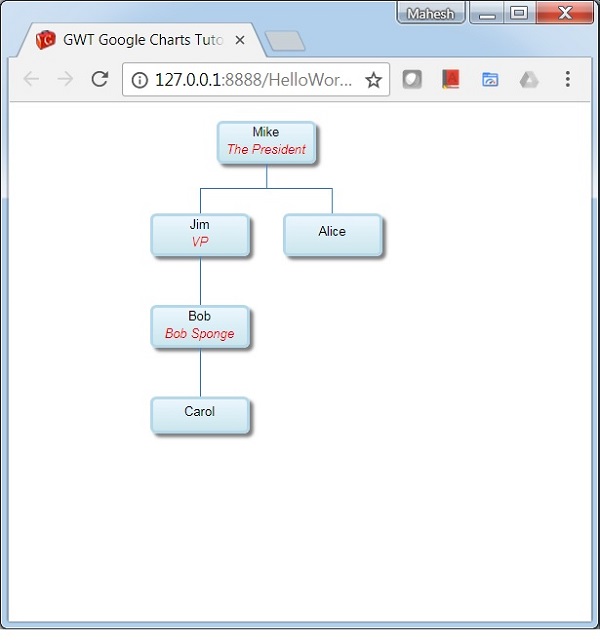GWT Google Charts - Organograma
A seguir está um exemplo de um organograma.
O organograma ajuda a renderizar uma hierarquia de nós, usado para retratar relacionamentos superiores / subordinados em uma organização. Por exemplo, uma árvore genealógica é um tipo de organograma. Já vimos as configurações usadas para desenhar um gráfico no capítulo Google Charts Configuration Syntax . Agora, vamos ver um exemplo de organograma.
Configurações
Nós usamos OrgChart classe para mostrar um organograma.
// Organization chart
OrgChart chart = new OrgChart();Exemplo
HelloWorld.java
package com.tutorialspoint.client;
import com.google.gwt.core.client.EntryPoint;
import com.google.gwt.user.client.ui.RootPanel;
import com.googlecode.gwt.charts.client.ChartLoader;
import com.googlecode.gwt.charts.client.ChartPackage;
import com.googlecode.gwt.charts.client.ColumnType;
import com.googlecode.gwt.charts.client.DataTable;
import com.googlecode.gwt.charts.client.format.PatternFormat;
import com.googlecode.gwt.charts.client.orgchart.OrgChart;
import com.googlecode.gwt.charts.client.orgchart.OrgChartOptions;
public class HelloWorld implements EntryPoint {
private OrgChart chart;
private void initialize() {
ChartLoader chartLoader = new ChartLoader(ChartPackage.ORGCHART);
chartLoader.loadApi(new Runnable() {
public void run() {
// Create and attach the chart
chart = new OrgChart();
RootPanel.get().add(chart);
draw();
}
});
}
private void draw() {
// Prepare the data
DataTable dataTable = DataTable.create();
dataTable.addColumn(ColumnType.STRING, "Name");
dataTable.addColumn(ColumnType.STRING, "Manager");
dataTable.addColumn(ColumnType.STRING, "ToolTip");
dataTable.addRows(5);
dataTable.setValue(0, 0, "Mike");
dataTable.setValue(0, 1, "");
dataTable.setValue(0, 2, "The President");
dataTable.setValue(1, 0, "Jim");
dataTable.setValue(1, 1, "Mike");
dataTable.setValue(1, 2, "VP");
dataTable.setValue(2, 0, "Alice");
dataTable.setValue(2, 1, "Mike");
dataTable.setValue(2, 2, "");
dataTable.setValue(3, 0, "Bob");
dataTable.setValue(3, 1, "Jim");
dataTable.setValue(3, 2, "Bob Sponge");
dataTable.setValue(4, 0, "Carol");
dataTable.setValue(4, 1, "Bob");
dataTable.setValue(4, 2, "");
PatternFormat format = PatternFormat.create("{0} {1}");
format.format(dataTable, 0, 2);
// Set options
OrgChartOptions options = OrgChartOptions.create();
options.setAllowHtml(true);
// Draw the chart
chart.draw(dataTable, options);
chart.setWidth("400px");
chart.setHeight("400px");
}
public void onModuleLoad() {
initialize();
}
}Resultado
Verifique o resultado.
